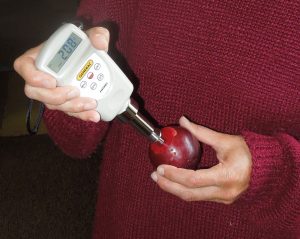Maturity Indicators
Many apple growers use the change in seed color from white to brown. However, by the time seeds darken to brown, it may too late to harvest apples that will be store short or long-term, particularly the variety McIntosh. A dark seed color is usually a sign that fruit are ripe and ready to eat. It is a poor indication of when to harvest for storage.
Ground color is a good indicator of fruit maturity for many varieties of apple, pear, peach, apricot and yellow plums. Areas of the skin with no red or purple coloration display the ground color or degree of green color. The skin contains chlorophyll which breaks down as fruit ripen so fruit display a change from green to yellow. When the fruit becomes over-ripe, the skin can change to orange in the case of peaches and apricots.

Yellow plums will change from green to yellow as they ripen. A few plum varieties will ripen very little after harvest and should be picked as close to ripeness as possible. Most varieties will rapidly ripen after harvest and should not be picked fully ripe, but with some green or light yellow remaining in the skin, the amount depending on how long it will take for them to reach market. Red and purple plums will develop additional skin color after harvest. Some varieties of plum will develop a dark purple skin long before they are ready to harvest, and should be picked based on flesh firmness.
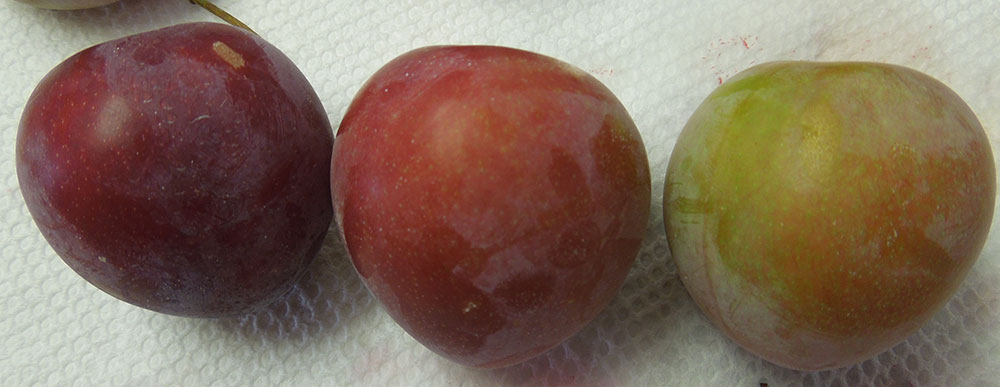
The ground color of peaches changes from green to pale yellow and eventually orange. The optimum stage of maturity depends on the duration between harvest and marketing. For a longer duration, fruit should be picked at earlier stages. Where fruit will be sold immediately, some yellow color can be allowed to develop, but fruit could develop brown rot when allowed to ripen on the tree.
The shade of light green or pale yellow that corresponds with optimum harvest depends on the variety. In the case of Cortland and McIntosh, optimum harvest date typically corresponds with a darker green than many other varieties. In the case of Honeycrisp, fruit picked when the ground color changes to pale yellow will hold up in storage if conditions are right. If picked at a green stage, fruit will develop bitter pit and will lack characteristic flavor.
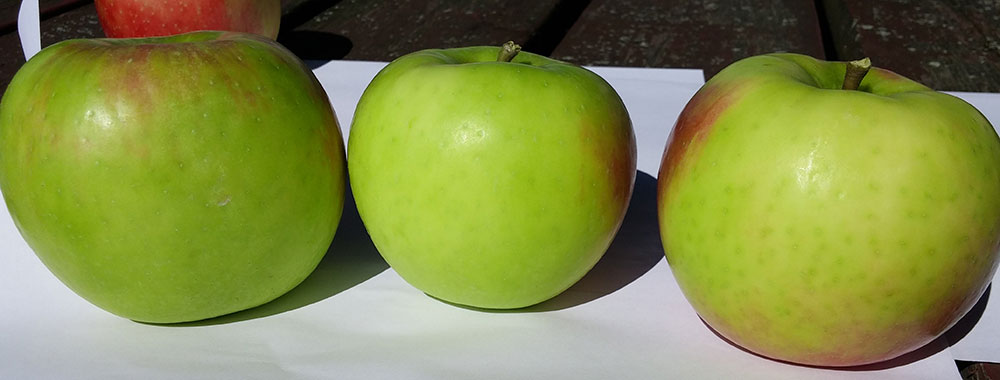
A useful test of maturity is the starch staining pattern of apples. The starch index test does not work for pears, peaches and other fruits. As apples begin to ripen, starch breaks down into sugars in the core first and then the cortex. Early stages of ripening correspond with starch breakdown in the core. As the last of the starch breaks down in the cortex, the apple is fully ripe and at a good stage for immediate sale. In most years, the beginning of the rise in ethylene corresponds with a certain level of starch breakdown that is characteristic of each variety. Heavy crop load reduces the amount of starch in fruit and can lead to poor interpretation of starch index.
Iodine stains starch a dark color. Areas of the fruit that have lost starch will remain unstained. When a cross-section of an apple is sprayed with an iodine solution, a characteristic pattern of stained and unstained flesh occurs. The starch index is an arbitrary number that corresponds with a certain amount of starch loss. A commonly used index ranges from 1 to 8 with 1 indicating no starch breakdown and 8 indicating complete breakdown.
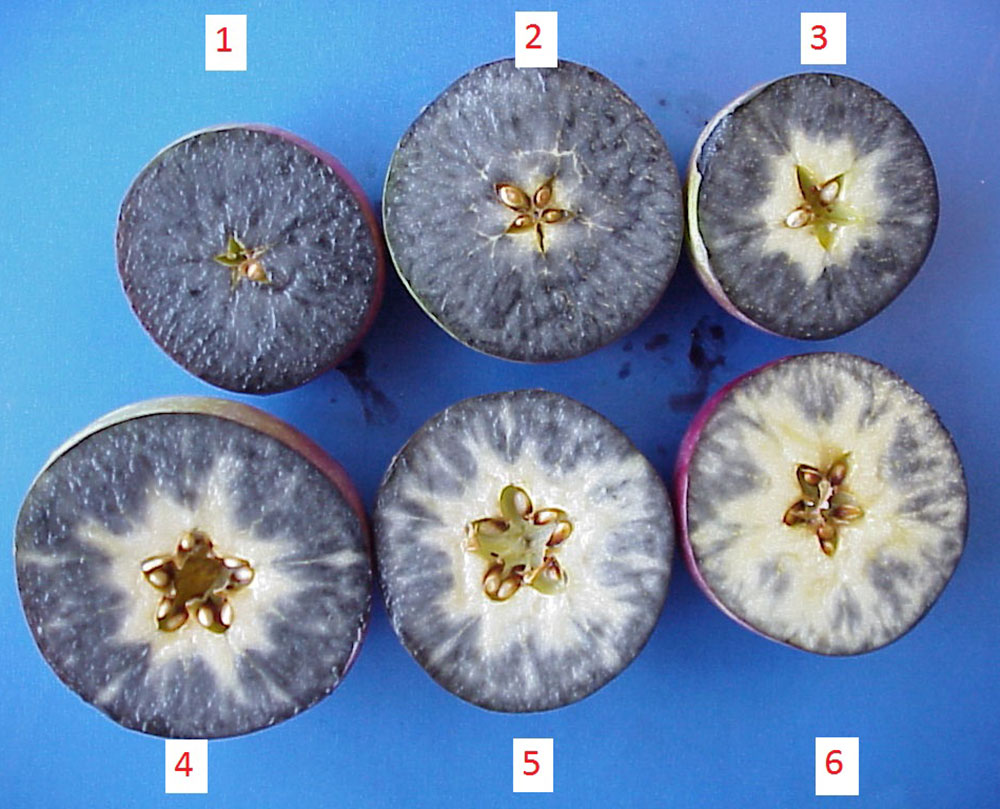

The iodine solution, made from potassium iodide and iodine, is light sensitive and must be kept in brown bottles or containers that light cannot penetrate such as a squirt bottle wrapped in aluminum foil. When not in use, the solution should be stored in darkness. It should be mixed fresh at the starch of each harvest season for best staining. Mixtures left over from the previous season will stain starch, but not as well.
To measure the starch index, select five to ten fruit from healthy trees with a crop load that is representative of the orchard. Slice each fruit half-way between the stem end and blossom end to expose the seed cavity. Squirt the cut surface, and wait one minute for the stain to darken. Record the index of each apple, and calculate the average. Compare your average index with a chart specific to the variety to determine if the variety has reached a stage for harvest.
For commonly grown varieties such as McIntosh, the starch index that coincides with the appropriate stage of ripeness for short and long-term storage has been determined. New varieties such as Honeycrisp do not have a well-established index of when to harvest for long-term storage. In this case, a combination of maturity indicators should be used including ground color, starch breakdown and flavor.
| Starch index that corresponds with optimum harvest for short and long term storage of apple varieties. | ||
|---|---|---|
| Short term storage | Long term storage | |
| Cortland | 3.0 – 4.0 | 1.5 – 2.5 |
| Empire | 5.0 – 6.0 | 3.5 – 4.5 |
| Gala | 5.0 – 6.0 | 3.0 – 4.5 |
| Honeycrisp | 6.0 – 7.0 | 4.5 – 5.5 |
| Jonagold | 5.0 – 7.0 | 3.0 – 4.5 |
| McIntosh | 5.5 – 6.0 | 4.0 – 5.0 |
| Macoun | 5.0 – 6.0 | 3.0 – 4.5 |
For pears, the most commonly used indicator of when to harvest is flesh firmness. When stored for a long or short time, pears should be harvested when they are still firm and green to prevent internal breakdown. Pears harvested ripe turn brown in the core after a short time in cold storage. Consequently, pears are picked before they are considered ready to eat, and when the flesh has reached a certain stage of firmness. The optimum firmness at harvest varies according to variety.
| Flesh firmness of pears that corresponds with harvest time for cold storage. | ||
|---|---|---|
| Pounds | Kilograms | |
| Bartlett | 17 – 23 | 7.7 – 8.6 |
| Bosc | 13 – 15 | 5.9 – 6.8 |
| Clapp’s Favorite | 17 – 19 | 7.7 – 8.6 |
| D’Anjou | 13 – 15 | 5.9 – 6.9 |
| Flemish Beauty | 10 – 13 | 4.5 – 5.9 |
| Packham’s Triumph | 13 – 15 | 5.9 – 6.9 |
| Starkrimson | 17 – 19 | 7.7 – 8.6 |
Harvest timing of plums can be based on flesh firmness. When plums will be shipped or held a short time prior to marketing, they should be harvested when flesh firmness softens to between 5 to 8 lbs. These fruit will continue to ripen and soften. If picked too soft, fruit that are stored or shipped will become over-ripe by the time they reach the consumer. Fruit that will be marketed quickly can be picked at a softer stage, generally 2 to 4 lbs. Most plums have a firmness of 2 lbs. or less when consumed. As plums ripen, they become more susceptible to rain cracking. The harvest of plums can be scheduled to avoid heavy rains if they have reach sufficient maturity. Methley plums that are harvested ripe are likely to crack in cold storage.
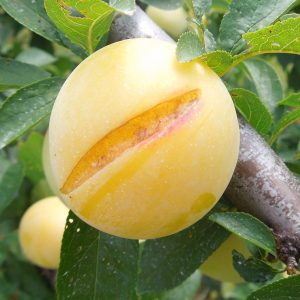
| Flesh firmness of Japanese plums that corresponds with optimum harvest. | ||
|---|---|---|
| Pounds | Kilograms | |
| Storage and shipping | 5 – 10 | 2.3 – 4.5 |
| Brief storage | 3 – 4 | 1.4 – 1.8 |
| Immediate sale | 2 – 3 | 0.9 – 1.4 |
To measure fruit firmness, pressure testers typically have a tip for plunging into the fruit. The tip is connected to a device that registers the pressure on a dial or electronic screen. To measure flesh firmness, slice off a piece of skin. Plunge the tip into the flesh till it is submerged to the indicator line. It should take one full second to plunge the tip into the flesh. If faster speeds are used, the tester will give a high reading. If too much time is used to plunge the tip, false readings will also occur. Read and record the firmness on a representative sample of fruit, usually a minimum of five fruit. To measure apples, use the 11 mm tip. For pears, plums and peaches, use the 7 mm tip.
